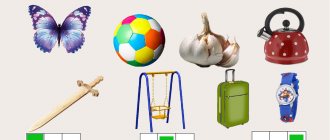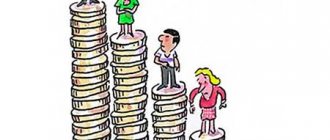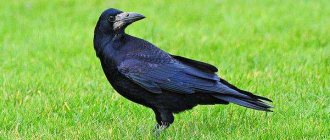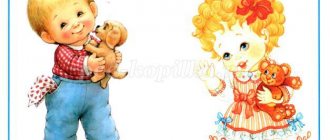Speech therapy lesson “Differentiation T-D” 1st grade
Topic: Differentiation T - D in syllables and words
Goal: Formation of the ability to isolate and distinguish sounds T-D in oral and written speech; clarification, expansion and activation of the dictionary; improvement of a detailed educational statement; development of attention, memory, stability and voluntary activity. Equipment. Pictures, signal cards, number series. Toys: kitten, bear cub, sets of geometric shapes, cards, colored pens, tangram.
Progress of the lesson
1. Organizational moment
The one who names words consisting of three syllables will sit down. Today we are going to our magical city of sounds and letters. But first, we need to prepare our speech apparatus. We sat down comfortably. Hands on knees.
2. Articulation gymnastics
"Smile." The thumbs and index fingers of the right and left hands are joined together. Steel fingers clenched into a fist. "Tube". Thumbs and index fingers joined together. Without opening, they move forward. "Spatula". The right and left palms are turned outward. "Cup". Cup-shaped palms. "Horse". Children march in place. "Fungus". The mushroom has grown - the legs are slightly bent, the knees look to the sides, the arms are raised above the head and bent at the elbows. Aging mushroom. The muscles relax, the mushroom ends up on the ground.
3. Voice exercises
We show the vowels a, o, u, y, e with movements. Gorka - we take the vowels out from under the bed and throw them on the closet and back.
4. Breathing exercises:
the balloon deflates, the balloon inflates. We move the walls. Relaxation: Ah, this spring sunny day.
5. Updating existing knowledge
- What is sound? - What is a letter? - What sounds are there? — How are vowel sounds pronounced? -What are they? — How are consonants pronounced? - What are the consonant sounds? - What is a syllable? -Which is longer, a syllable or a word?
6. Explanation of new material
In the city of sounds and letters there are always a lot of interesting poems and riddles, proverbs and tongue twisters. Say a familiar tongue twister in robot style: A woodpecker lived in an empty hollow, chiseling the oak tree like a chisel.
— What sounds are most often found in this tongue twister? (D-T)
From this series, name sounds similar in articulation: o, t, i, d, p, u. How are they similar? Comparison.
7. Consolidation of new material
1).We listen and memorize syllable series.
| Yes - ta To - do Dia - cha Tu - do Diti | ta - yes - ta yes - ta - yes those - those - de yes - ta - ta - yes yes - ta - ta - yes |
2) What letter represents the sounds t - t in writing? (letter “t”) What letter in the letter represents the sounds d – d? (letter “d”) Show on the table. 3) Reading syllable rows to music.
| Yes - do - do - dy Ta - that - here Di - de - dia - du | ti - te - cha - tu yes - to - du - you ti - de - dia - tu |
8. Finger gymnastics
Self-massage. Count your fingers. What words have the sounds d and d? (seventh, ninth, tenth) Which words have the sounds t and t? (second, third, fourth, fifth, sixth, ninth, tenth). Which words have both sounds? (ninth, tenth) What words do not have these sounds?
9. Open your notebooks and write down the date
Encrypt the words: if you hear a word with the sound d, draw a circle, if the word contains the sound t, draw a square. plate, pipe, traces, rooster. Now let's decipher these words. So…
10. Listen to the words and label them graphically.
Write the letters t and d above the corresponding syllable. Melon, road, woodpecker, skating rink, acorns.
11. Physical exercise.
Game “Listen to the Claps” One clap - stand up like a heron; Two claps - stand up like a soldier; Three claps - frog
12. Consolidation of new material
1) Sound-letter analysis of words based on pictures: duck, melon. 2) The kitten loves all objects that have the sound t or t, and the bear cub loves objects that have the sounds d and d. They took some of these objects with them on the road, but while they were driving, all the objects got mixed up, help them sort out their luggage . Shovel, picture, plate, star, sneakers, trumpet, honeycomb, pumpkin, apron, radio. Place objects with sounds t and t next to the kitten, and objects with sounds d and d next to the teddy bear. 3) Compare pairs of words by sound, spelling, meaning. Duck is a fishing rod. Write the words in your notebook. To make a sentence. Conclusion: sounds and letters should not be confused.
13. Lesson summary
So: A sound is what we are... A letter is what we are... Voiced consonant sounds are... D-D Voiceless consonant sounds are... T-T In writing, the sounds d and d are indicated by a letter. In writing, the sounds t and t are represented by a letter.
Author of the material: Kurbanova Zoya Efimovna
Also on topic:
T-D differentiation in words
Publications on speech therapy
And the presentation.
Target:
clarify and compare the articulation and sound of sounds [d', t'].
Objectives:
• teach children to differentiate sounds, enrich children's vocabulary;
• develop skills of syllabic analysis and synthesis; consolidate knowledge of language norms; • promote the development of coherent speech, higher mental processes (development of voluntary attention, auditory memory, motor skills). Learn to establish cause-and-effect relationships. • cultivate perseverance, hard work, and a sense of teamwork. Equipment:
for the teacher: presentation for the lesson, coloring books with a picture of a fairy, for students: workbooks, pens, pencils, counting sticks.
Progress of the lesson: 1. Organizational moment.
– Today we had fabulous guests come to our lesson, and you will find out who exactly by solving the crossword puzzle (slides 2,3).
Highlight the first letter of the first picture (flag – f) + F – The second letter of the name of the second picture (swan – e) + E – the last letter in the name of the third picture (sleigh – i) + I – From the resulting letters, make up the word + Fairies 2. Introduction with the heroes of the lesson and announcement of the topic.
– That’s right, the charming fairies Tinkerbell and Tintin came to our lesson (slide 4).
– They will help us learn to distinguish between their favorite sounds Дь and Ть (slide 5). 3. Pronunciation and characteristics of sounds (slide 6)
+дь ь + Sound Дь – consonant, voiced, soft, paired + Sound Ть – consonant, voiceless, soft, paired
4. The connection between sound and letters.
– Let’s write beautifully, neatly in a notebook the capital and lowercase letters Dd and Tt (sample on the board)
5. Development of phonemic awareness, game “Show the letter”
– I will name the words, and you, if you hear the sound D, make a roof over your head with your hands, it turns out letter D, if you hear the letter t, make a T with your hands (raise your left hand and place your right hand horizontally on top, you get the letter T). - So, we prepared our ears, we listen carefully: uncle, aunt, silence, delegate, model, tiger, dinosaur, dolphin, disco, rhyme, academy, Pinocchio, Thumbelina, girl, porcupine, kindergarten, airplane, pediatrician... - Well done! The next task is to connect objects with the corresponding letters with lines (slide 7).
6. Differentiation of sounds in words (work in notebooks)
– The fairies really liked this game, they had so much fun that they accidentally spilled magic powder on the words and their favorite letters flew away, let’s help them return the letters to their places (slide 8).
– Write down the words by filling in the missing letters. 7. Physical exercise “Fairies” (slide 9)
Fairies, fairies flew, sat quietly on the flowers.
They got up, sat down, got up, sat down, got up, flew again! They spun and twirled and sat down in their places! 8. Development of motor skills.
– Ting-ding and Ting-ting haven’t been home for a long time, and they really miss their home, let’s cheer them up and make their favorite castle out of sticks (slide 10).
9. Differentiation of sounds in the text
- Having seen their castle, they missed their parents even more and decided to write them a letter, but look what happened: they mixed up the letters D and T (slide 11).
Let's help them correct their mistakes, rewrite the letter in a notebook, correcting the mistakes they made: Dear Rotidels!
I write to you your dots Ting-ting and Ting-ding! Everything is fine with us, we came to Gosdi for a lesson, we are learning sounds and letters. We'll get to Tomoi soon! – Let’s check what we got (slide 12).
10. Homework
- Now you can send a letter, the parents of the fairies will be able to read it, in gratitude for this Tinker Bell and Tinkerkin give you their photographs, but unfortunately they are black and white, perform magic with colored pencils and turn black and white photographs in color.
11. Summary of the lesson
- Let us remind our guests what sounds we learned to distinguish during the lesson?
(T, d.) - Give a brief description of these sounds? (Ть - consonant, deaf, pronounced without the participation of the voice, soft. D - consonant, voiced, voice is involved in pronunciation, soft.) - Why did we learn to distinguish these sounds? +To write without errors. – Let's say goodbye to the fairies and wish them a happy journey! +….




